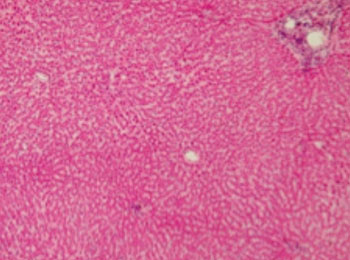Developmental Biologists Locate Source of Liver Stem Cells
By LabMedica International staff writers
Posted on 19 Aug 2015
Researchers have identified a stem cell line that is responsible for the generation of liver cells (hepatocytes), which are constantly required to maintain the health of the organ.Posted on 19 Aug 2015
Working with mice, investigators at Stanford University (Palo Alto, CA, USA) traced the lineage of hepatocytes by determining expression of the Wnt-responsive gene Axin2 (axis inhibition protein 2). The WNT gene family consists of structurally related genes that encode secreted signaling proteins. These proteins have been implicated in oncogenesis and in several developmental processes, including regulation of cell fate and patterning during embryogenesis.

Image: Cross-section of the human liver (Photo courtesy of Wikimedia Commons).
The investigators reported in the August 5, 2015, online edition of the journal Nature that they had identified a population of proliferating and self-renewing cells adjacent to the central vein in the liver lobule. These pericentral cells expressed the early liver progenitor marker Tbx3 (T-box 3), were diploid, and thereby differed from mature hepatocytes, which are mostly polyploid. The descendants of pericentral cells differentiated into Tbx3-negative, polyploid hepatocytes, and could replace all hepatocytes along the liver lobule during homeostatic renewal. The population of liver stem cells was maintained by Wnt signals provided by endothelial cells in the adjacent central vein.
"We have solved a very old problem," said senior author Dr. Roel Nusse, professor of developmental biology at Stanford University. "We have shown that like other tissues that need to replace lost cells, the liver has stem cells that both proliferate and give rise to mature cells, even in the absence of injury or disease. Differentiated hepatocytes have amplified their chromosomes. That is, the cells have more than the usual two copies of every chromosome. This enables the cells to make more proteins, but it really compromises their ability to divide."
Related Links:
Stanford University













